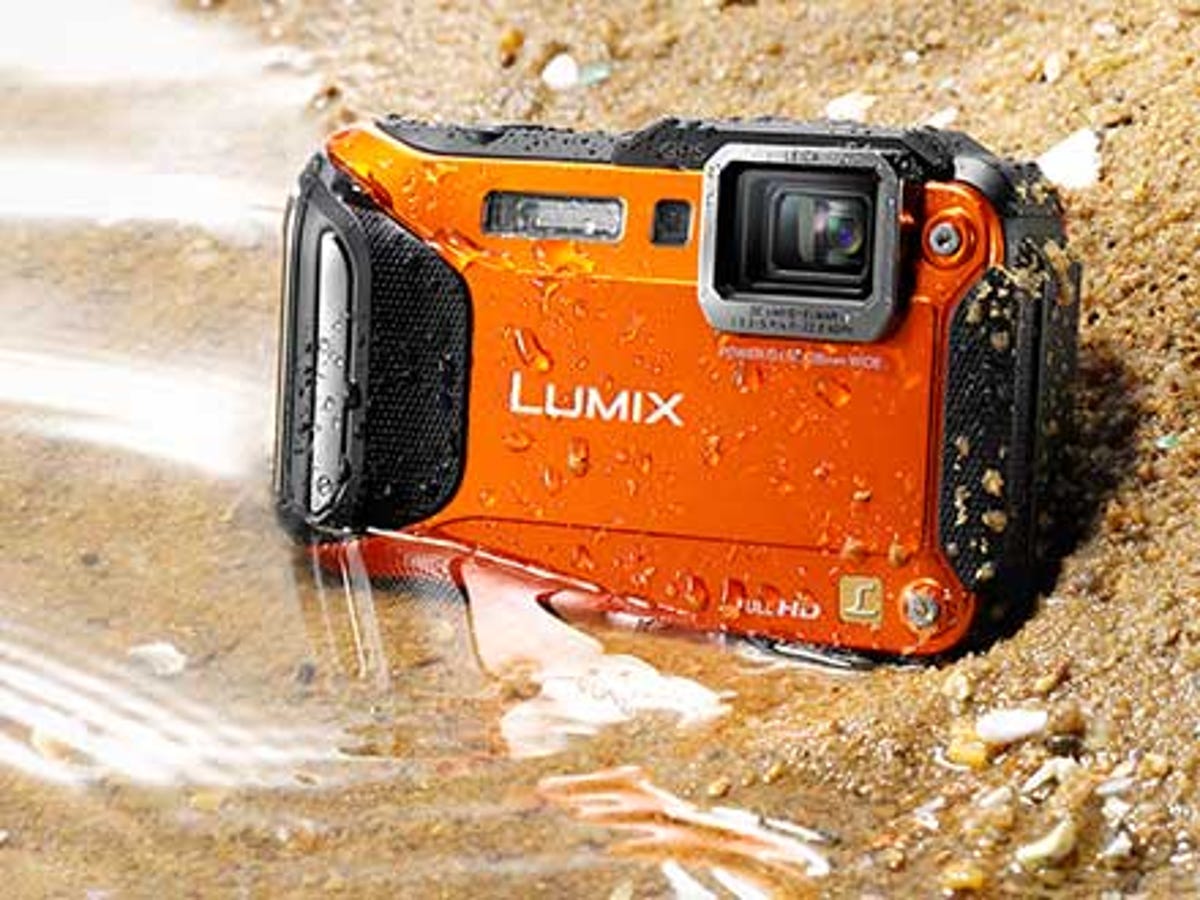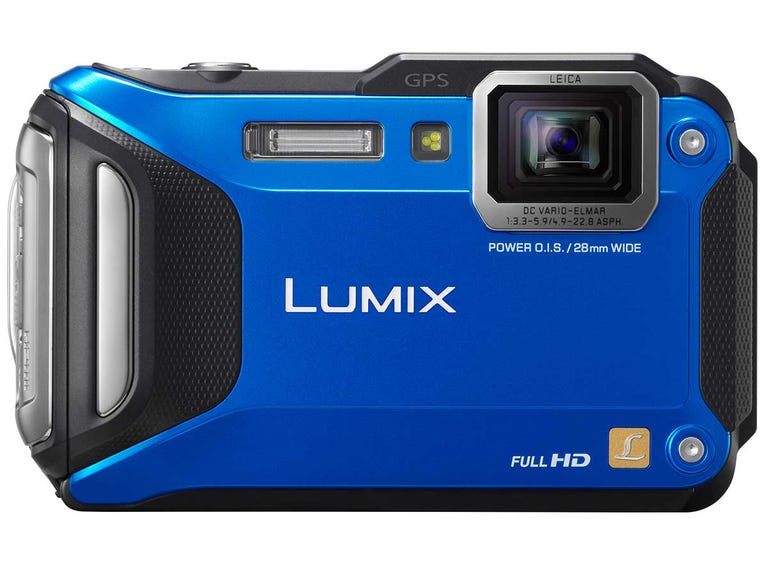 Why You Can Trust CNET
Why You Can Trust CNET Panasonic Lumix DMC-FT5 review: Panasonic Lumix DMC-FT5
The Lumix DMC-FT5 is a truly rugged compact camera that's happy being dropped, drowned and frozen.
Building something that's both attractive and rugged is a tall order. In the FT5, Panasonic's just about pulled it off.
The Good
The Bad
The Bottom Line
The latest in a fairly long line of rough, tough cameras, it's yours for around £350.
Rugged construction
There's nothing subtle about the FT5, but then it has been built for an active, outdoor life. The battery and SD card compartment locks in place, there are no moving parts outside of the airtight case -- so the lens, for example, is captive behind a window -- and every opening has been carefully sealed. That's because it's waterproof to 13m (43ft), which is more than many casual watches. If you need to take it any further, you'll have to invest in a marine casing.

My test sample also came in a hi-vis orange case, which would make it easy to see if you dropped it while climbing, walking or swimming. There's a better than average chance you'd still be able to use it once you'd retrieved it too, as it's designed to survive a fall of 2m and being chilled to a distinctly frosty -10C (-14F). For mountain-climbing swimmers in Iceland it's pretty much perfect.
That also makes it a good choice for kids, or parents who won't necessarily be able to keep an eye on their camera the whole time, as short of it being thrown a significant distance, it should be able to withstand a fair amount of juvenile mishandling.
I tested it by knocking it off a garden table -- a fairly likely pub scenario -- putting it in a bowl full of water, and submerging it in a saltwater estuary. It passed each test with flying colours. The sturdy window to the front also meant I wasn't afraid to dry off the lens assembly using a regular handkerchief afterwards.
Under the hood
It's not all about what goes on outside, though, as under the hood the FT5 has some pretty decent specs. The sensor is a 16.1-megapixel chip producing 4,608x3,456 pixel stills. Despite being held captive behind a fixed window, the lens still offers an optical zoom of 4.6x, which in this instance matches its focal length to that of a 28-128mm assembly on a regular 35mm camera.
You have a limited amount of manual control, with an M mode allowing you to tweak both the shutter speed and aperture, although at any zoom level you have a choice of only two aperture positions, which is disappointing. At wide angle it's f/3.3 and f/10, while at full telephoto it's f/5.9 and f/18. Each of these metrics varies at zoom levels in between.
The minimum focusing distance at either end of the zoom is 30cm in regular use, and 5cm in macro mode. That's not especially close, so you may want to crop your results in post-production, but the image exhibits a pleasingly shallow depth of field to draw the eye nonetheless.
The results were also good when stepping out of macro mode, with the bust below shot using the regular minimum distance at wide angle. The exposure was a fairly long 1/8 second at f/3.3, but despite being hand held it's produced a crisp, clean result.
Maximum sensitivity in regular use is ISO 3,200, with a high-sensitivity option pushing it up to ISO 6,400 in extreme situations. Naturally, when you start to approach the extremes there's going to be more grain in your image. This was evident in my tests, with shots taken at ISO 3,200 significantly less clean than those taken at a more reasonable level. In these instances, fine detail was degraded and grain was evident on areas of flat colour.
Exposure compensation lets you stray two stops in either direction, in 1/3EV steps, and you can bracket each exposure by up to 1EV.
In regular use, the longest possible exposure is a rather disappointing four seconds, which isn't really enough for effective night-time cityscapes as your trailing headlights will be short, and buildings could be underexposed. Switching to the 'Starry Sky' scene mode uncaps it somewhat, and will leave the sensor exposed for up to 30 seconds.
Other recording modes include a dedicated advanced underwater setting for photography below 3m (10ft), and a less extreme beach and snorkelling setting.
Networking features
As with an increasing number of Panasonic's cameras, the FT5 has built-in Wi-Fi, which allows you to shoot directly to a PC on the same network, or to control the camera remotely from a smart phone.
It also has an integrated GPS chip, which you can set to geocode your stills and videos
Stills performance
You'd have to be a pretty extreme sports fanatic to make use of all of this camera's rugged features, so it's important image quality has been sacrificed to make room for them. As well as dropping and flooding it, I therefore also conducted all of the usual image shooting and video tests.
Despite the hefty lens protection, images remain sharp, with clean edges and well-defined contrasts. The petrol pumps below were shot using the FT5's Intelligent Auto setting, which tasks the camera with making all of its own decisions where focus and exposure are concerned, and the result is a well balanced frame with generally sharp details, although there is a slight drop in clarity around the trigger of the right-hand pump.
Detail retention was generally very good, however with plenty of texture captured in complex shots -- such as the tomb stone below -- which has been aged over several decades. The moss and lichen on its surface are very clear right across the shot.
There is a slight lack of uniformity across the frame when you examine scenes shot square on and compare the centre and corner of the image. In the shot of the door below, for example, there is a distinct falling off towards the corners where, in the upper portion, the flints appear to be slightly smeared in favour of the corners, indicating that while bending the incoming light from these areas to reach the sensor the lens hasn't quite done such a good job of keeping it in focus as it did at the centre where the light passes through in a straight line.
Despite this, it's very difficult to find any evidence of chromatic aberration in my test results. This is an undesirable fringing effect where contrasting edges are haloed by a third colour that's not visible to the naked eye.
Finally, the FT5's in-camera panoramas, which are cropped to around 850 pixels in height, were a little disappointing. Although easy to shoot (you just swipe the camera across the scene before you) some of the stitching is less than perfect. I tested it by shooting a fairly complex boatyard and the result had some duplicated features, such as flags, and slightly mis-aligned overlays giving what should have been a sharp edge a slight ghosting.
Video performance
The FT5 shoots either AVCHD or MP4, depending on whether you want to record for HD TV or PC playback. I used the former in my tests, but it's important to be aware of the fact that this locks you in to a frame rate of 60fps, either progressive or interlaced at resolutions of both 1,920x1,080 and 1,280x720. You might therefore need to down sample it before editing it in a consumer video app.
The footage itself kept up a very high standard throughout my tests, with accurate colours and a high level of detail both consistent features. Despite the wind cut feature being set to auto however (the only other option is off), there was still considerable wind noise on the soundtrack when filming by the coast.
Conclusion
The FT5 represents a significant upgrade in almost every respect over its predecessor, the FT3 (there was no FT4). Crucially, it has a higher resolution sensor, keeps out the water at 13, rather than 12m, shoots movies at higher frame rates and has far better buttons and a larger screen round the back for a more pleasant experience altogether.
Along with the Canon PowerShot D20, it's one of the best rugged cameras you can buy. It's not as pretty as the Canon, but it is better specced to reflect the fact that it's also newer.
It's a great rugged option for anyone with an active lifestyle or, as I mentioned earlier, who needs a child-poof photography tool. You'll pay a premium, though, with prices advertised at between £307 and £410 online. In practice, expect to pay around £350.
Considering this camera has a better chance than most at lasting a very long time, that doesn't seem altogether unfair.


